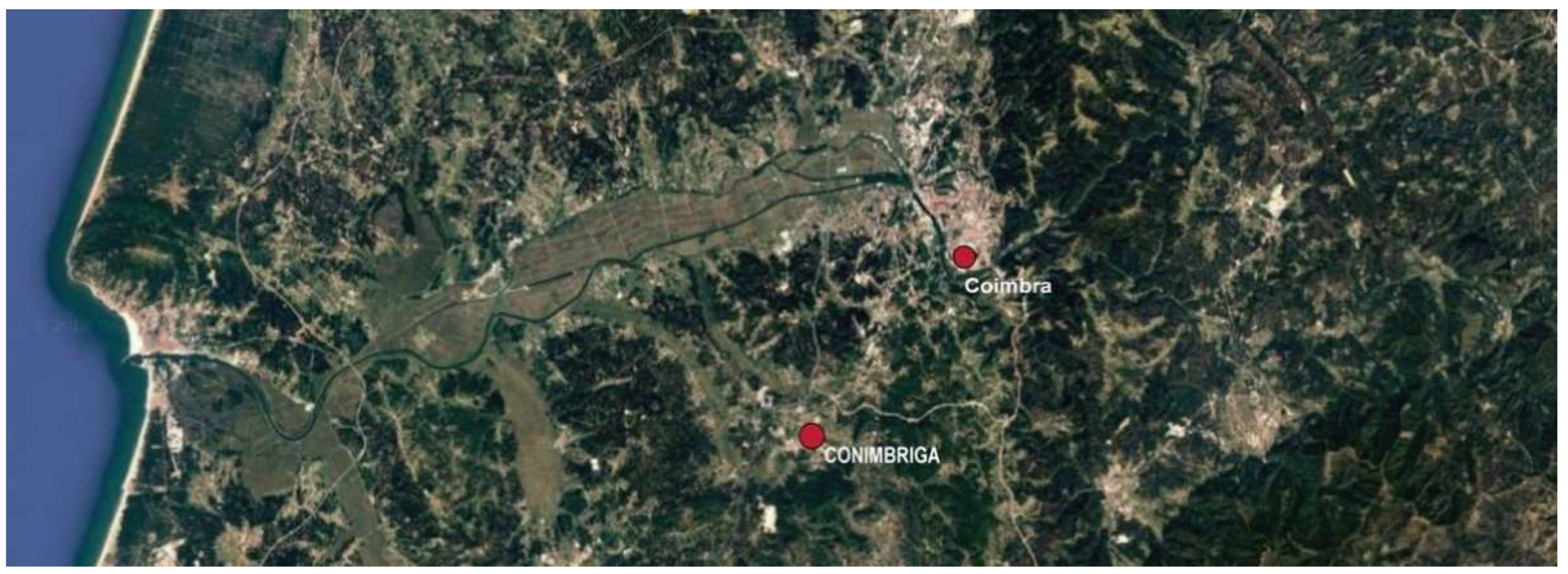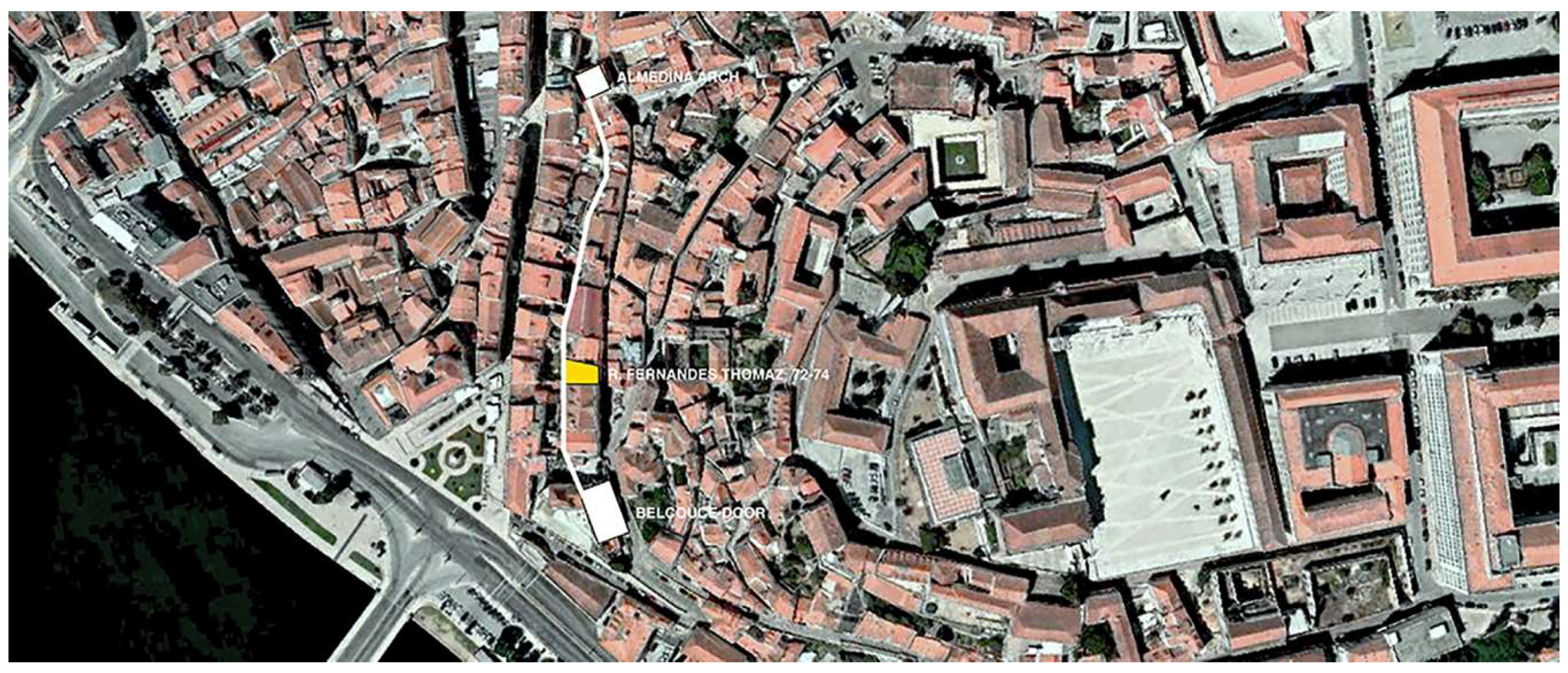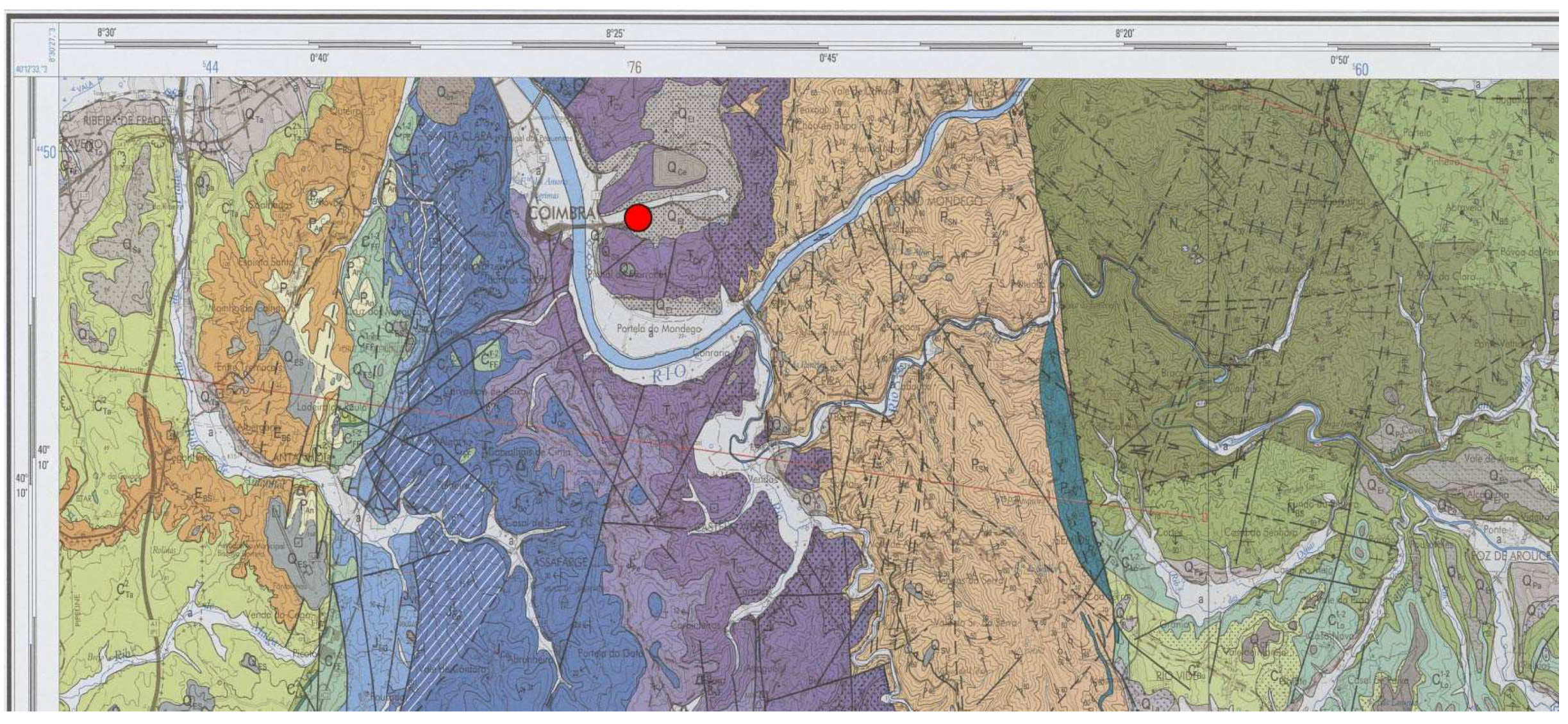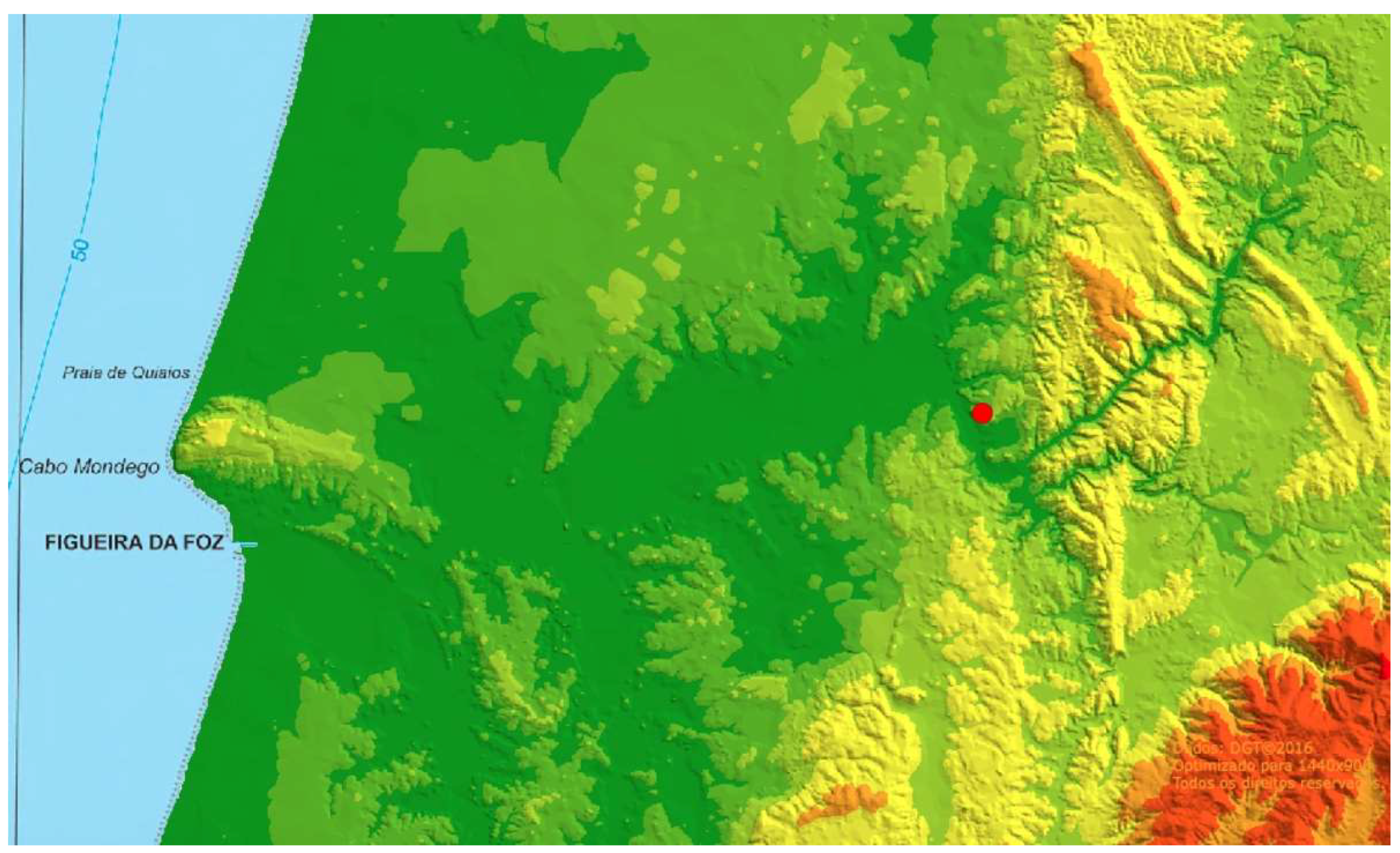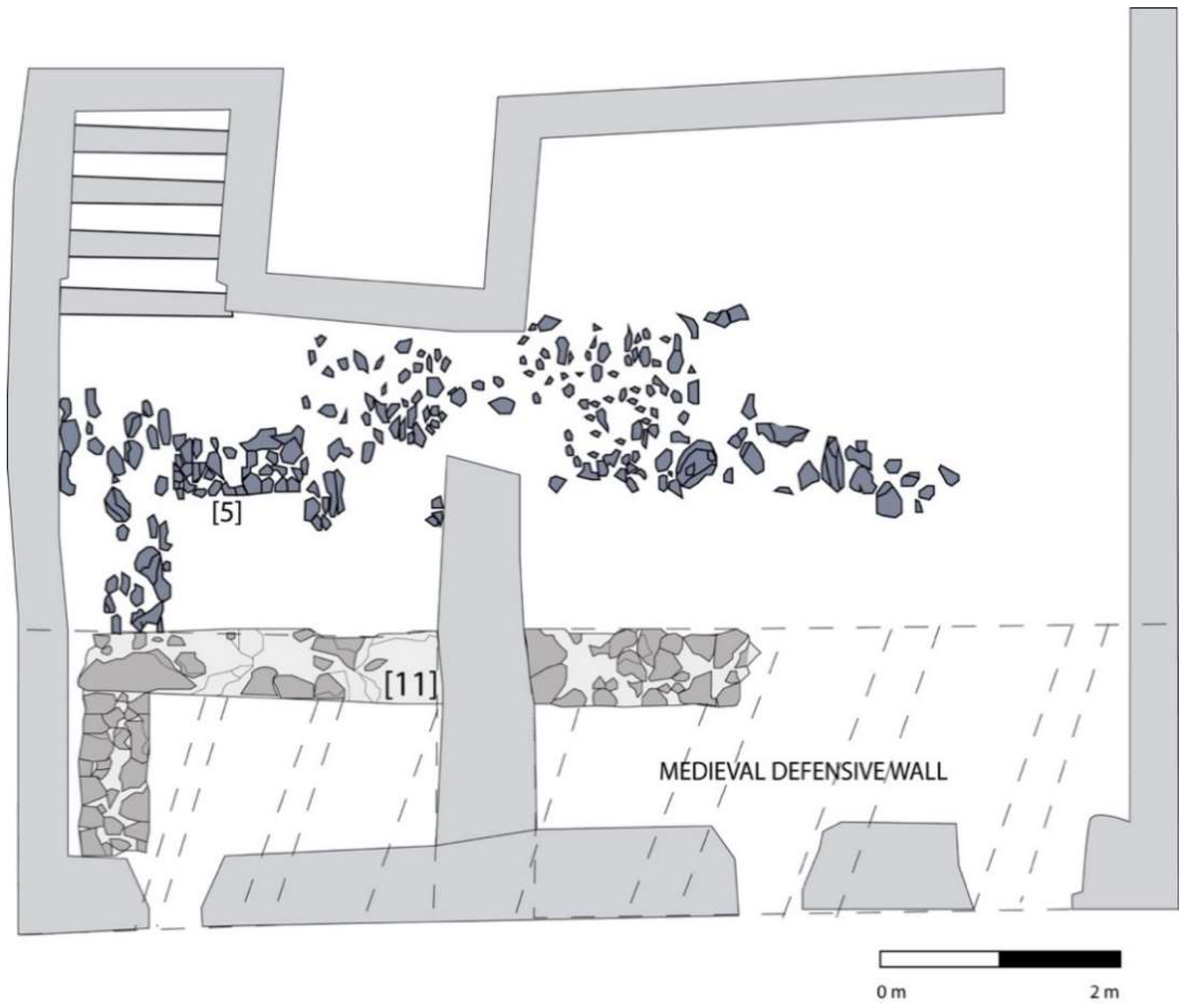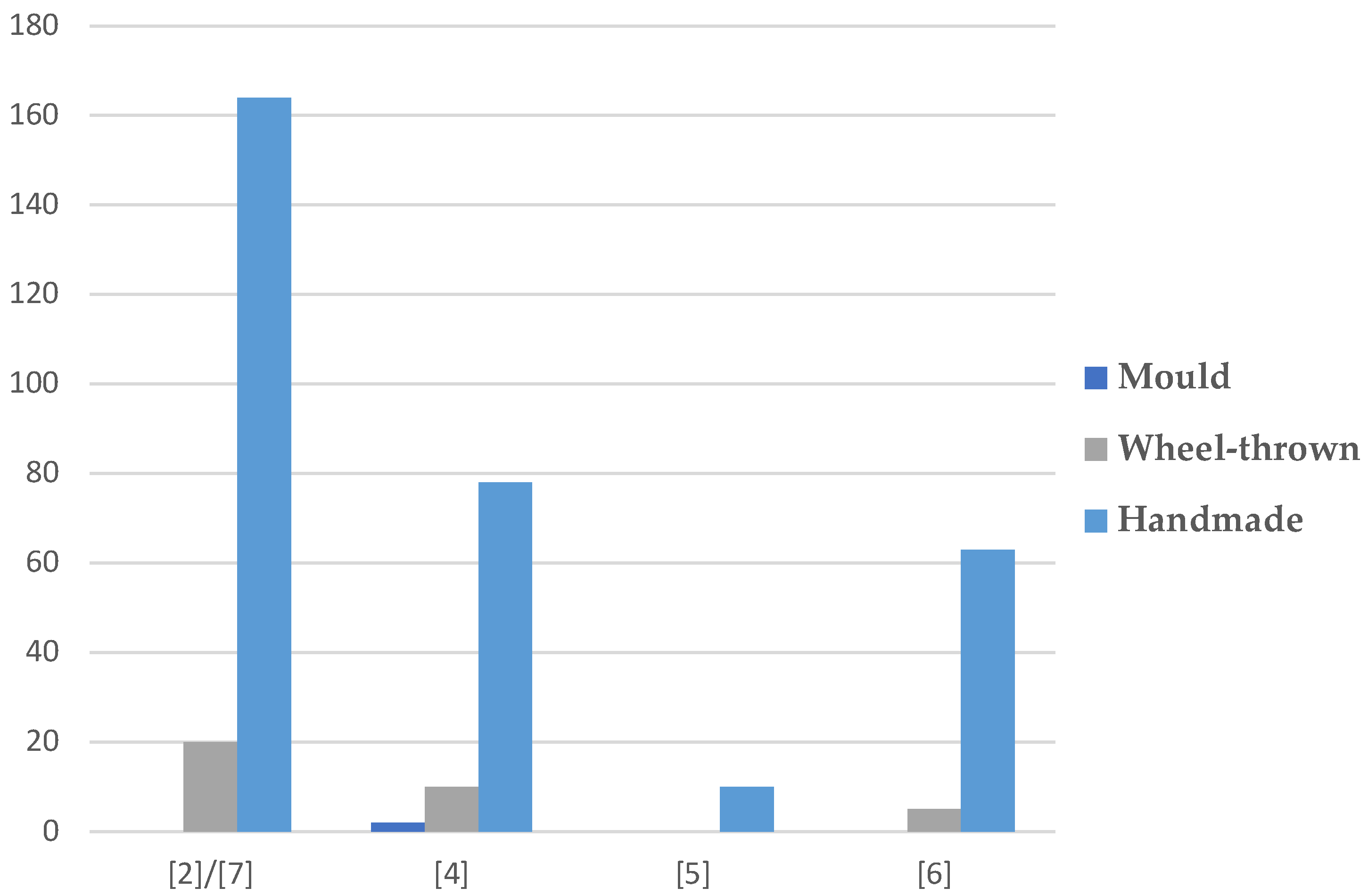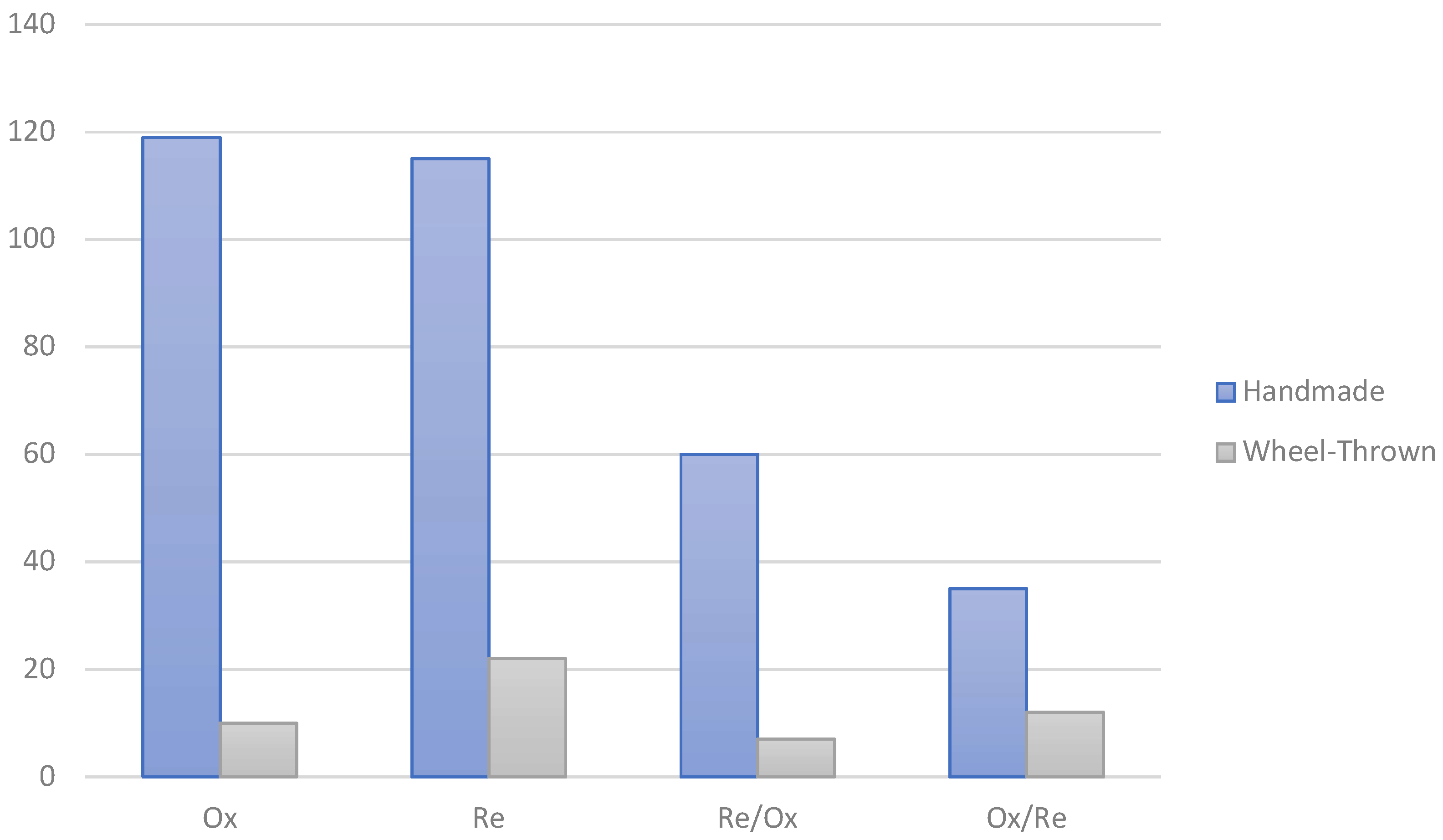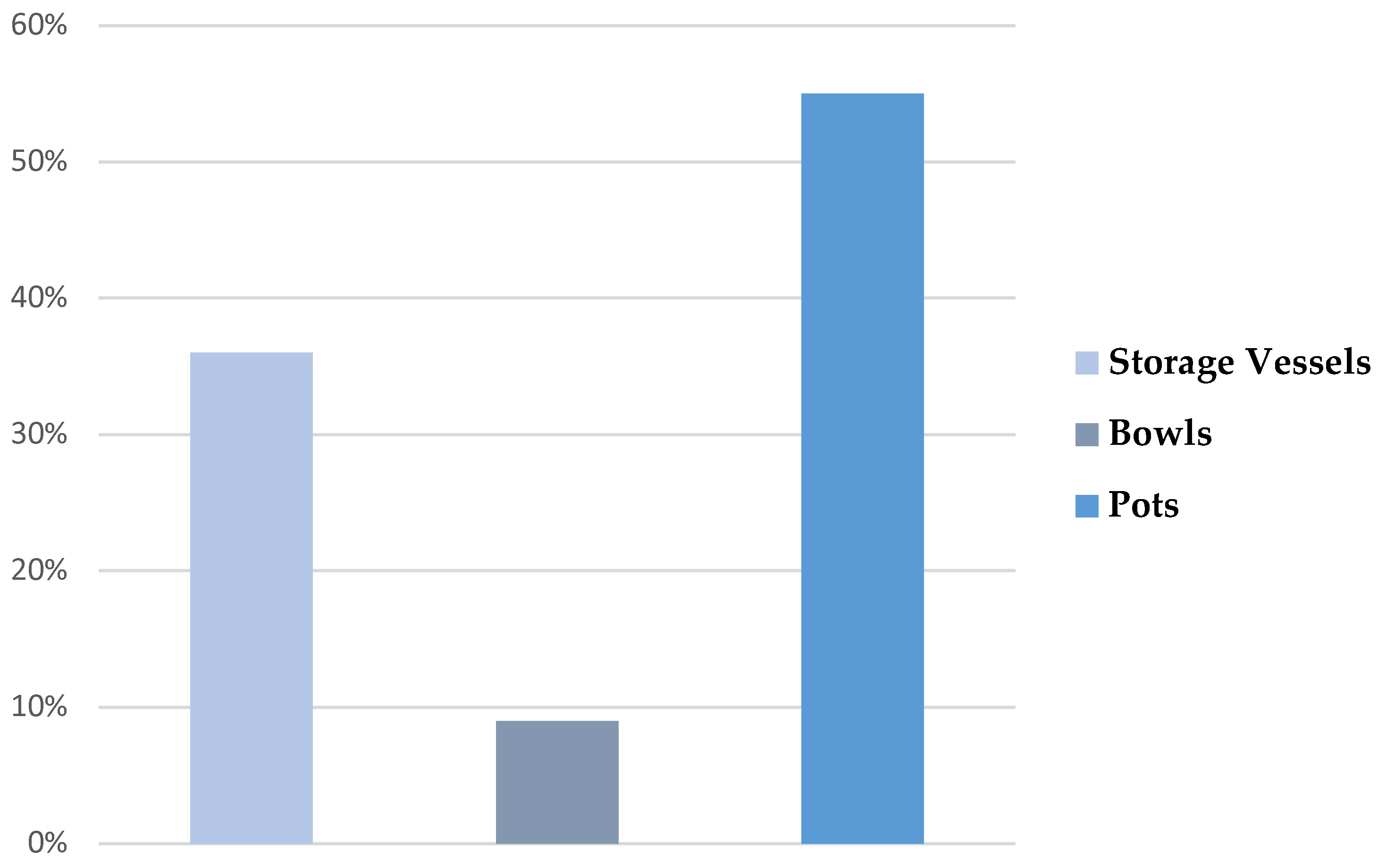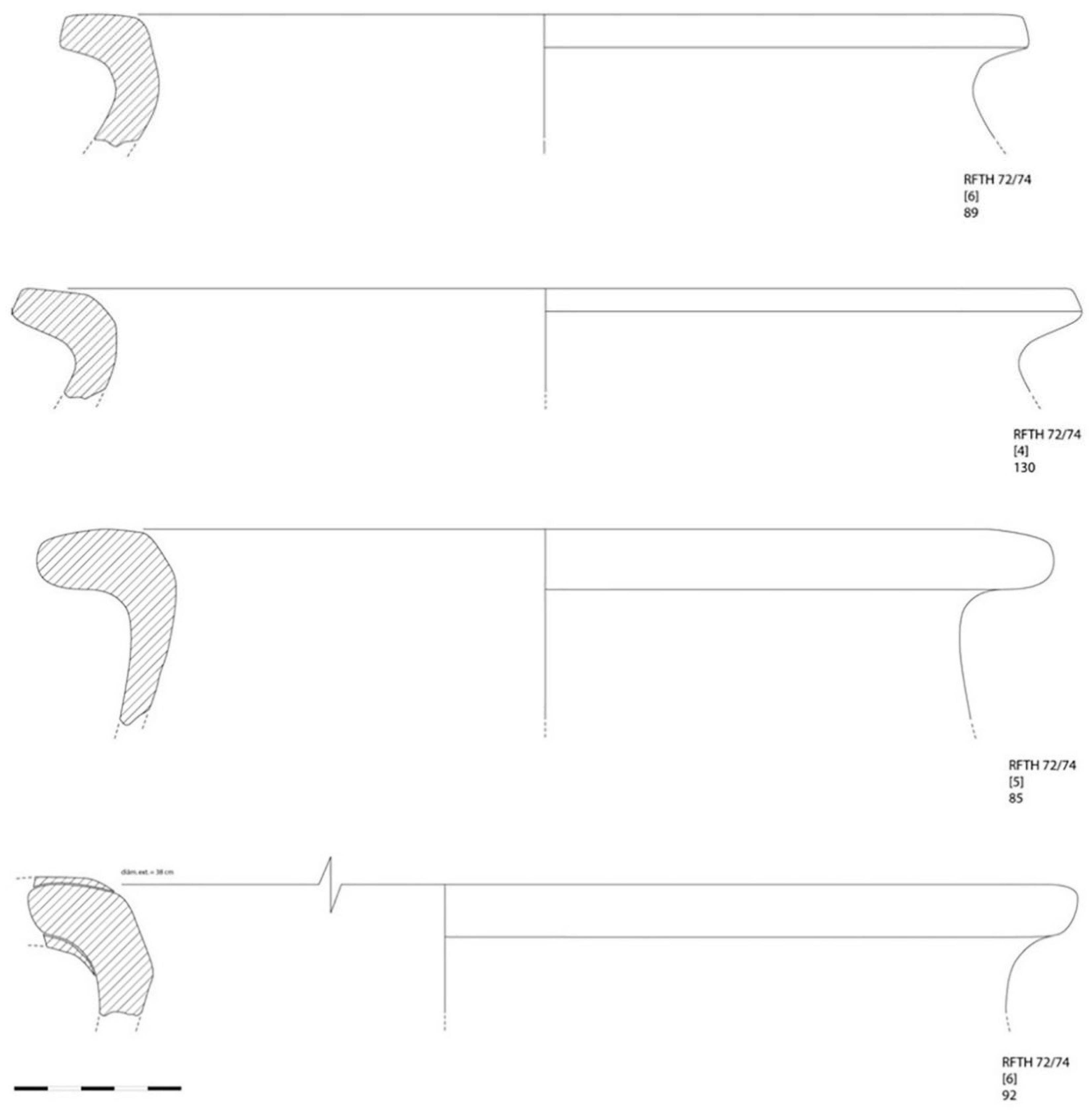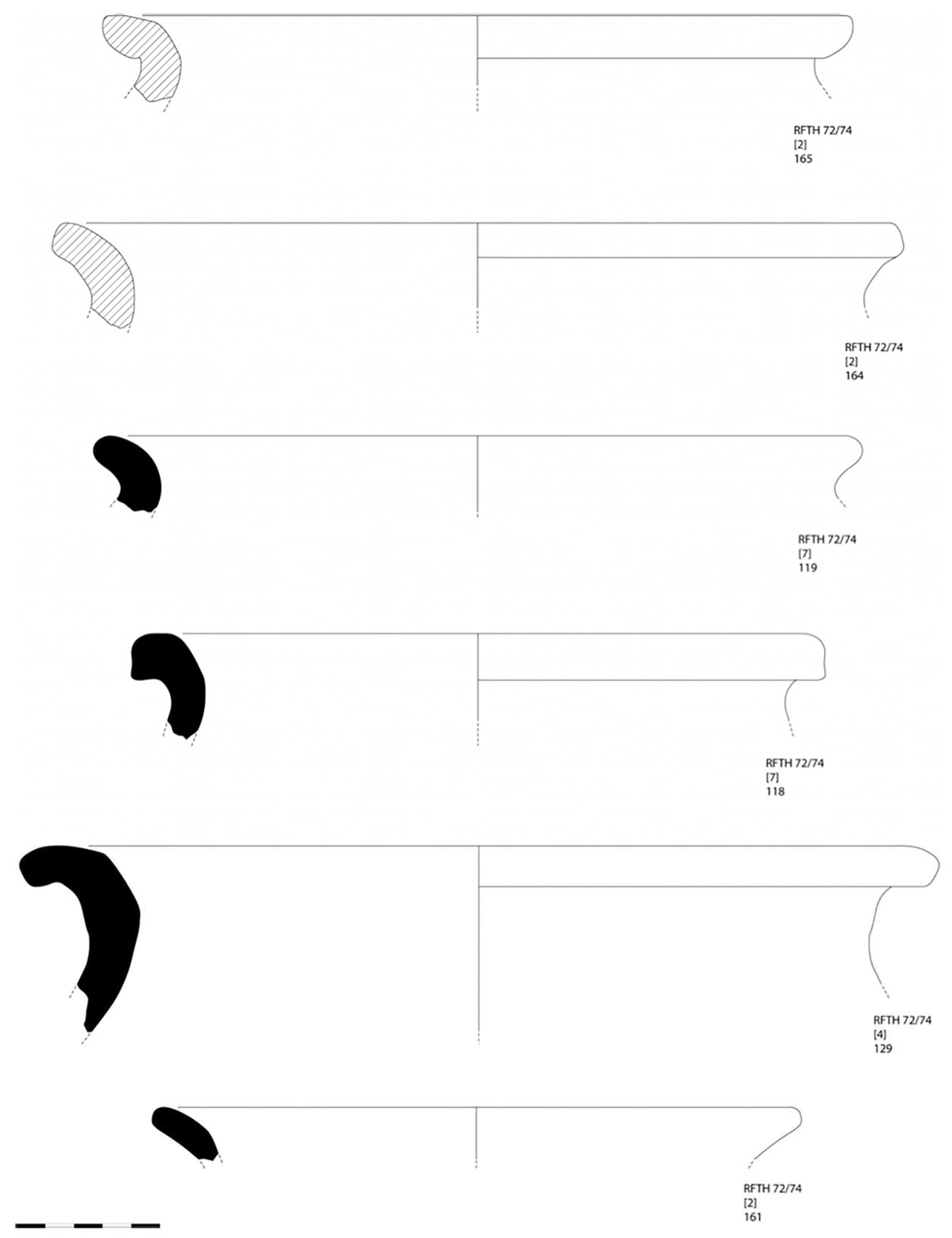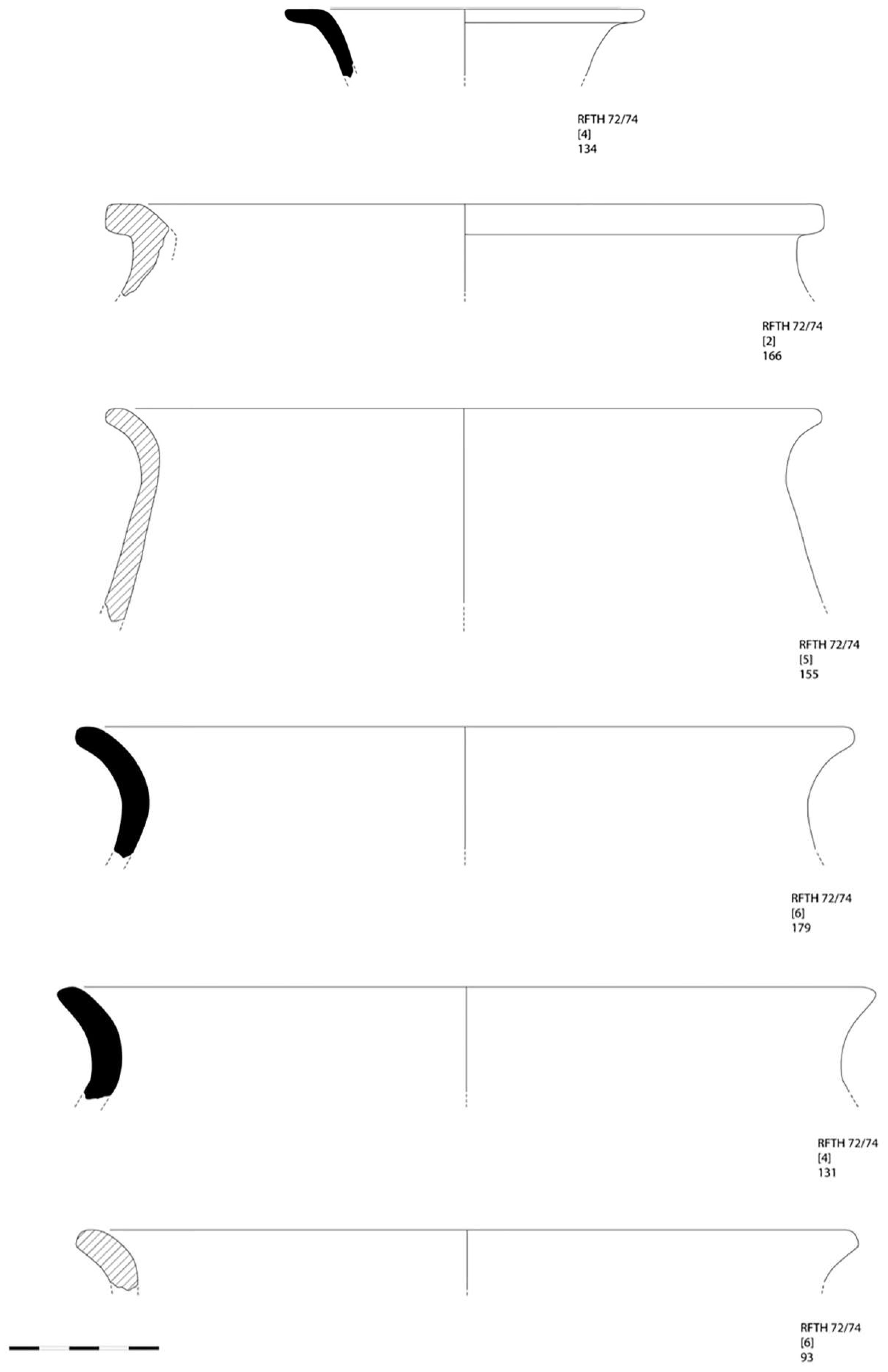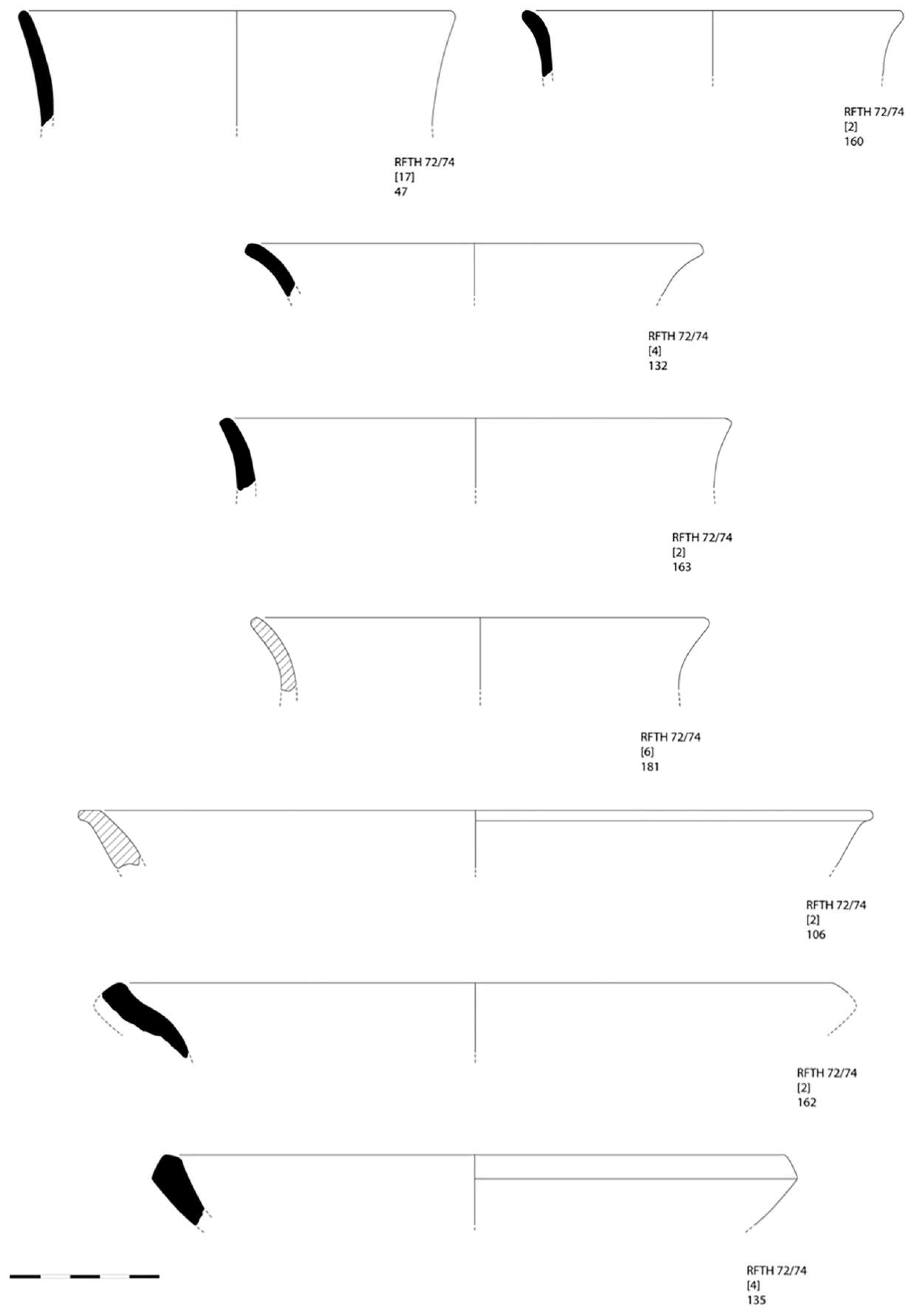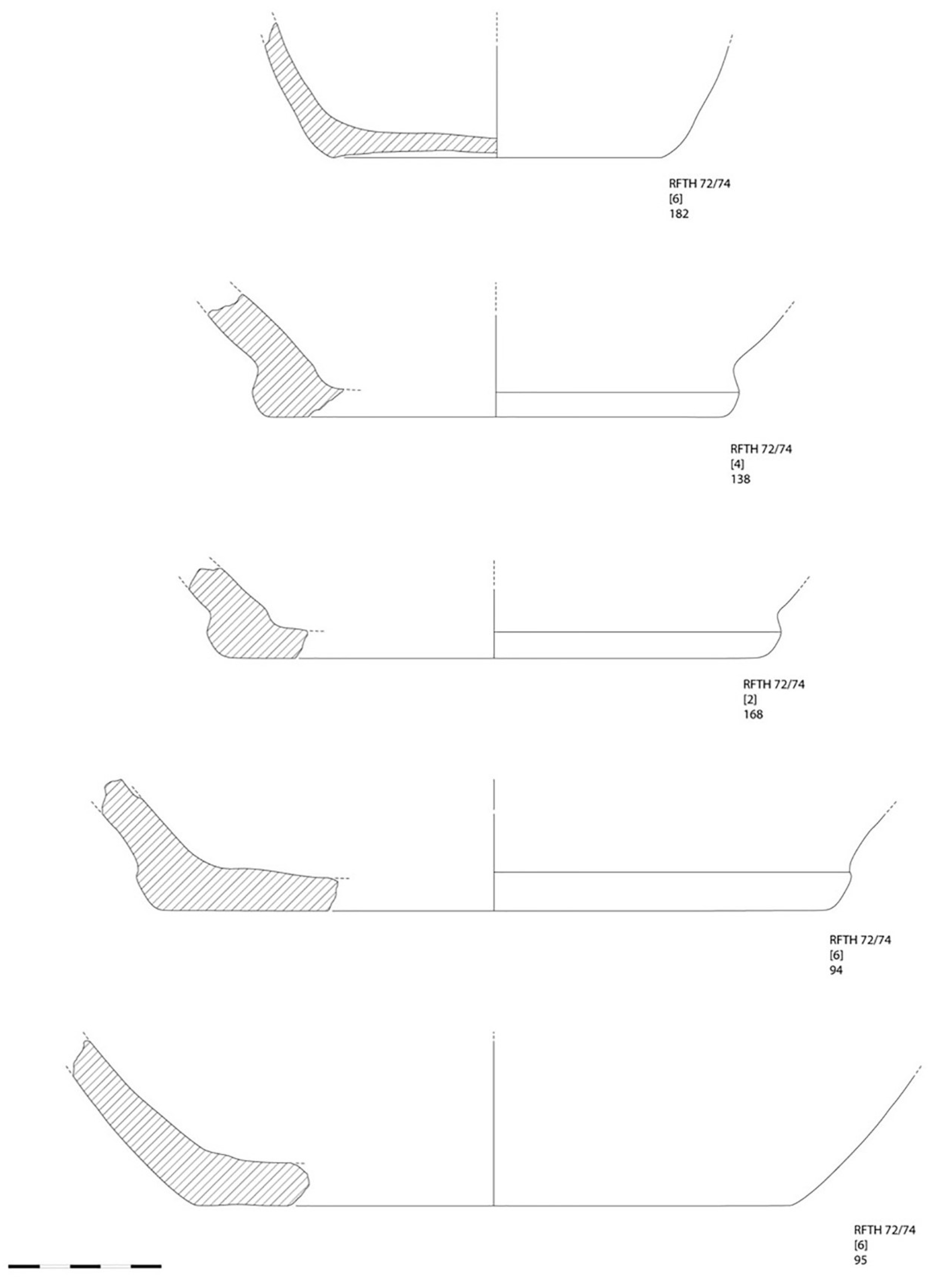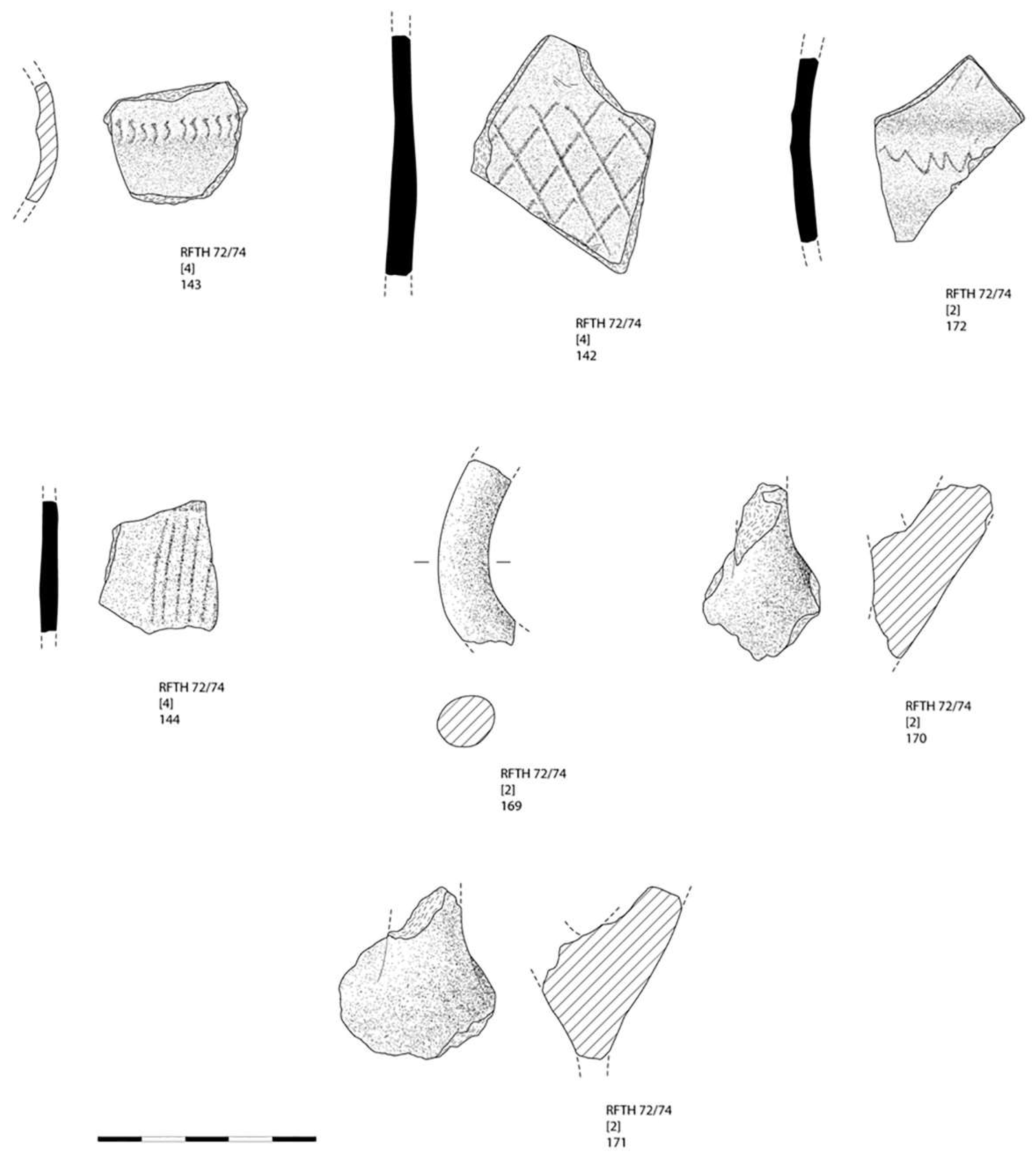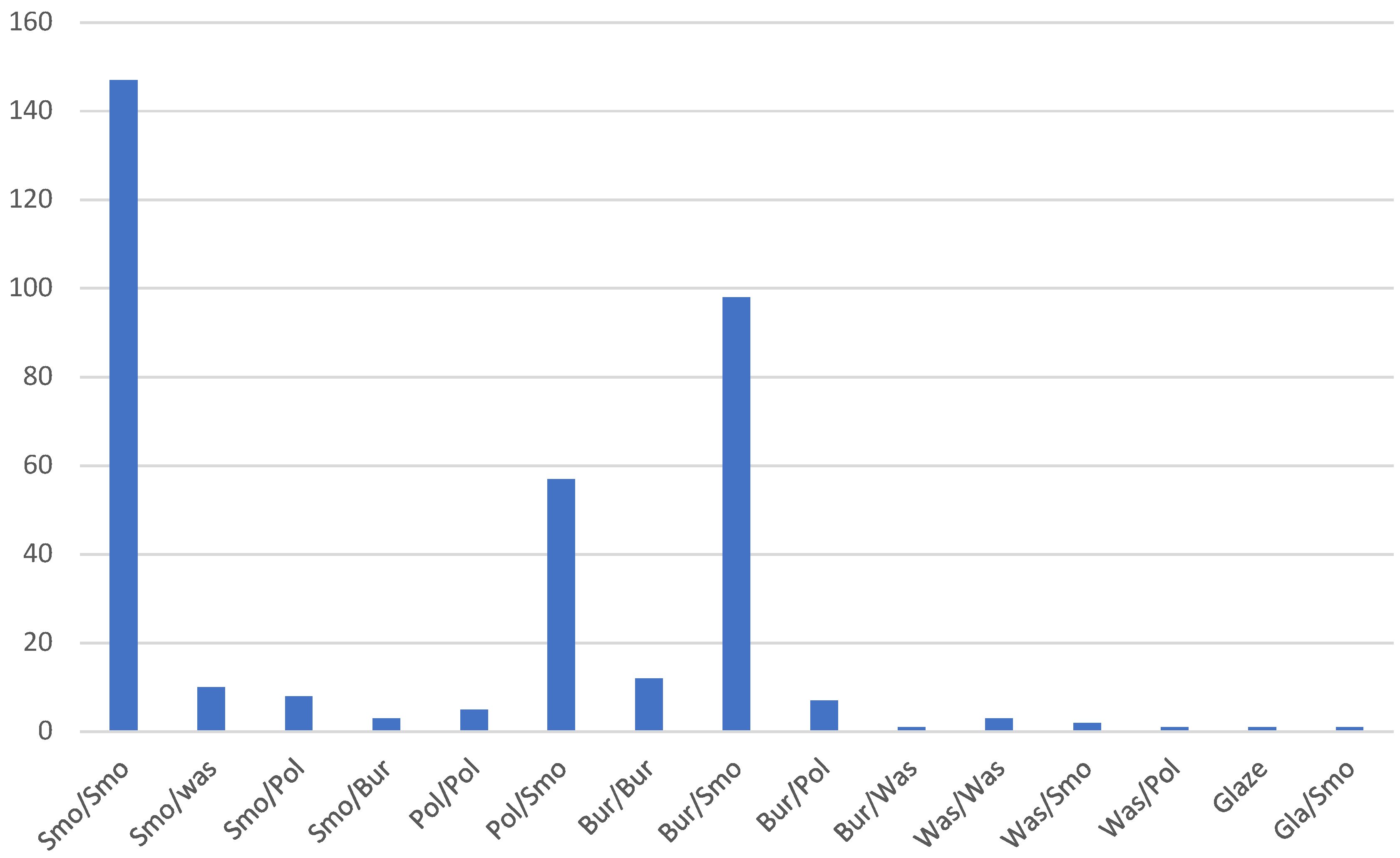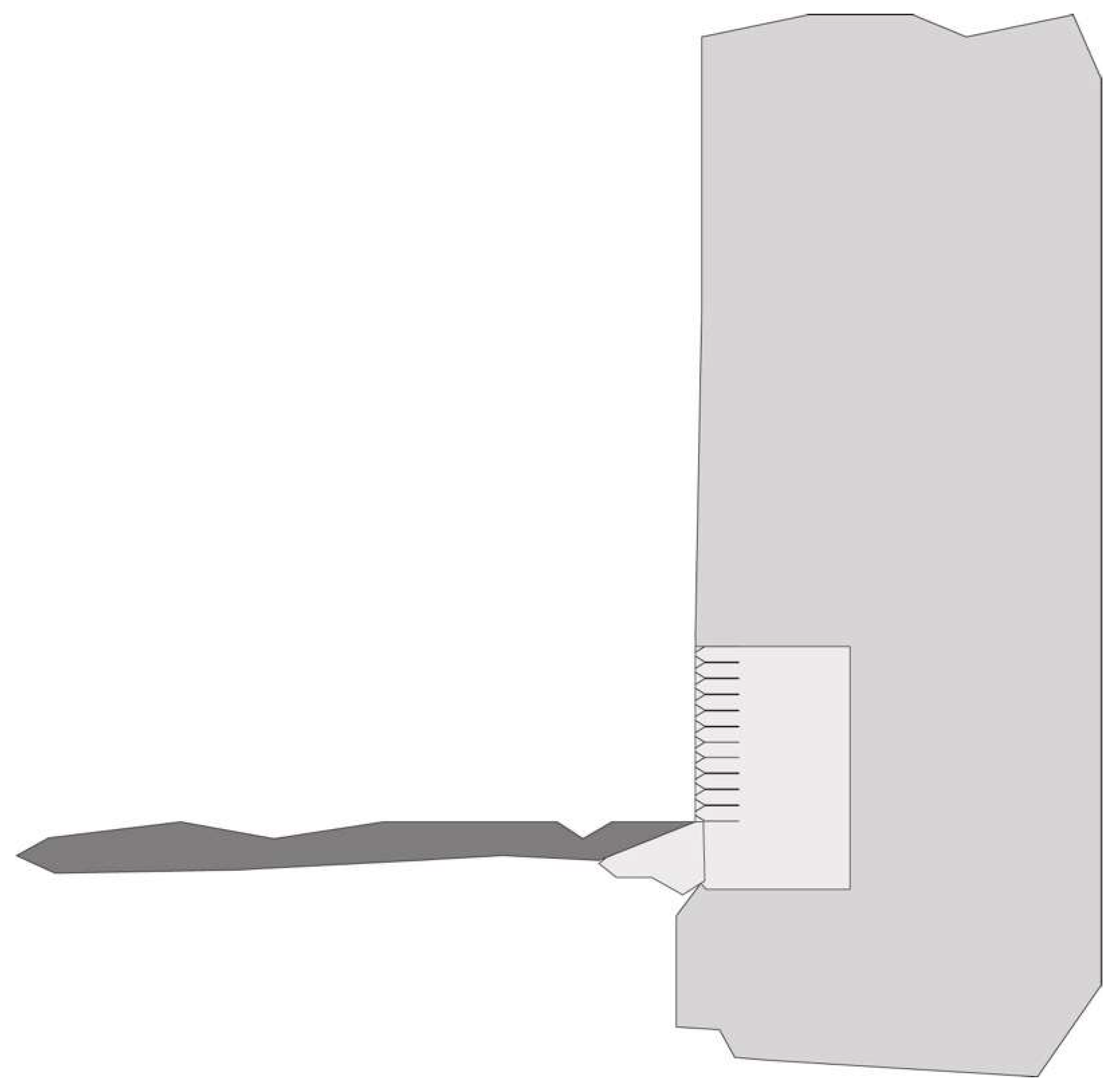1. Introduction
Besides the occasional findings throughout the inner-walls of the city of Coimbra [
1,
2,
3,
4,
5,
6], few interventions have revealed such an important set of heritage items as that found in the Rua Fernandes Thomaz.
The archaeological remains from the Rua Fernandes Thomaz, by virtue of their rarity and the oldest items uncovered, merit disclosure for further debate in the scientific community. For this reason, the results of this archaeological intervention intend to close a gap in the knowledge of Iron Age realities and the first contact with the Roman world, creating a base for future studies.
In addition to the findings in the Machado de Castro Museum, namely the monumental cryptoportico that supported the
Aeminium Forum, the Patio of the University of Coimbra and the Colégio da Trindade sites, few places in the city reveal signs of Roman occupation. In terms of pre-Roman presence, the signs are even rarer, only visible in the levels of destruction that were carried out in order to build the
Aeminium Forum, namely the presence of a pre-Roman alignment, a possible dwelling expropriated by the Roman administration to build the administrative seat of the city [
4] (first century A.D.). Already in the site of the Patio of the University, an intervention has identified alignments of walls at the level of its foundations, which may well date back to pre-Roman occupation, but already quite destroyed, and another set of alignments associated with a possible thermal complex. In the Colégio da Trindade, a set of structures was found, associated to a Roman occupation similar to that found in the Patio of the University of Coimbra [
5].
Regarding the chronological contexts covered, the city of Coimbra has few material vestiges, considering that during the 1950s, during construction of the university city, massive earthworks were carried out, altering the physiognomy of the city and destroying almost all evidence of chronological occupation. The first reference to the existence of
Aeminium appears in the Antonine Itinerary, that sought to identify the points of passage of Roman roads on the map of the current Portuguese territory. The map, published at the beginning of the third century A.D., located the city of
Aeminium about 16 kilometres north of
Conímbriga. Both
Aeminium and
Conímbriga (
Figure 1) were crossed by a Roman road, which linked
Olisipo (the name given by the Romans to present-day Lisbon) to
Bracara Augusta (present-day city of Braga) [
7]. The ancient city expanded in the fifth century A.D., more precisely between the years 465 and 468, when the neighbouring town of
Conimbriga was sacked and destroyed by the Suevi, a group of Germanic peoples who dominated part of the Iberian Peninsula between 409 and 585 A.D.
Before the invasion of the Suevi, many inhabitants of Conímbriga settled in Aeminium, a city that previously functioned as a civitas capital, i.e., the seat of a political-administrative division of the conimbrense territory. Due to displacement of the previous inhabitants of Conímbriga the number of inhabitants of Aeminium increased, leading to its growth and greater prosperity. This growth eventually led to Aeminium being renamed: in the sixth century it was renamed Coimbra.
The data presented is the result of a combined study conducted by the two authors, collected during the urban requalification works which uncovered important archaeological artefacts, thereby providing clearer evidence of the pre-Roman presence in this city, opening new discussions in the archaeological community.
This study discusses a pottery sample, the biggest so far discovered in the city of Coimbra, in conjunction with the article published for the diagnosis of the archaeological dig conducted in this building [
6].
1.1. Methodological Basis
At the methodological level, the rare findings presented in this analysis are based on the intrinsic factors of the fragments identified, i.e., on the characteristics present in the pulp, the internal and external surface and the production process. The factors extrinsic to the ceramics (location in the excavation area, stratigraphic provenance, and functionality) are also mentioned. The external features associated to the functionality of the items, in particular the edges, have been classified into separate groups.
We analysed the internal and external surfaces in terms of their homogeneity and treatment. The homogeneity of the surfaces was subdivided into homogeneous and non-homogenous, and the treatment was subdivided into categories, according to the applied technique, namely smoothing, polishing, burnished and washing. In rare cases, the application of varnish occurs in ceramic fragments that are exogenous to the area.
Smoothing means the uniformity of the surface of the item, created using a semi-hard object (e.g., piece of leather, hand, fine comb, etc.) giving a matte appearance and revealing marks of the objects used that are imprinted on the wet paste. For example, a number of thin and irregular parallel marks appear, denoting some flexibility, conveying the idea that a type of comb or brush made from an organic material (vegetable fibres, animal hair, etc.) was used.
The polished surfaces have a shiny appearance, resulting from friction using a hard, smooth object (pebble, bone, horn, etc.) on the semi-dry pulp. In relation to burnishing, the technique is the same as polishing, but occurs at a later stage of drying the item, assuming a much brighter and homogenous appearance. This action, when carried out carelessly, leaves spatulated surfaces with horizontal faceted glare, showing the edges left by the instrument used.
The washing or slaking process is the application of a liquid coating, of a clayish nature, which is applied after drying and before firing the item. This action can be carried out simply by passing a wet hand over the workpiece to smooth it out, causing non-malleable elements to be covered by a thin layer of clay [
8]. Although documented for common ceramic manufacture during the Roman era, this characteristic is found in all the Iron Age fragments found in the Rua Fernandes Thomaz nº72/74, in which the washing technique was identified.
It is important to define the treatments of surfaces identified in this ceramic set, whose starting point is the assumptions adopted by Raquel Vilaça [
9] in her PhD thesis, although referring to previous chronological realities, they can be applied to the ceramic set from the late Iron Age identified in Coimbra (from the fifth century B.C. to the second century B.C.). The study, at a more comprehensive level, respects the methodological assumptions defined by Clive Orton [
10].
The characteristics of the pulp were analysed considering the following assumptions: structure (homogeneous or stratified), type of inclusions (quartz, mica, calcite, ceramics, coal, gold mica, feldspar, black particles and ferruginous elements), size (very fine 0.0–0.1 mm, fine 0.1–0.25 mm, medium 0.25–0.5 mm and large 0.5–1 mm), frequency (uncommon, frequent, very frequent) form (round or angular), distribution of inclusions (regular or irregular) and finally baking of the paste (oxidant, reducer, oxidant with reducing cooling and reducer with oxidant cooling).
By the following present cooking it is understood that oxidising (Ox) cooking has a uniform colouration within the shades of orange, red and yellowish brown. Reducing cooking (Re) has grey, dark brown and black tones. Oxidising cooking with reducing cooling has a lighter core than the rest of the item, while an oxidising cooling reducing cooker has a darker core.
This analysis was conducted at a macroscopic level and for all the Iron Age ceramic fragments (edges, backgrounds, bulges, wings, decorated fragments).
1.2. Geomorphological Introduction
The building in the Rua Fernandes Thomaz 72–74 is located in the western area of the city (
Figure 2), overlooking the River Mondego, on a steep slope, with a natural propensity for the implantation of a strong line of defense [
11]. It is situated between the Porta de Belcouce and the Almedina Arch. The back of the building is constituted by part of a defensive structure.
Geologically the area is inserted in the western part of the Meso-Cenozoic sedimentary basin, where sandstone, limestone, dolomitic lime and sands are the predominant sedimentary formations (
Figure 3) [
12].
2. Archaeological Results
The archaeological intervention in this space is due to the rehabilitation of the building. During the diagnostic stage [
13] several structures were found, mainly part of a defensive wall, probably medieval, part of the back wall of the building and a wall reused during construction of the medieval wall, in an L shape. This L-shaped wall has Roman characteristics, possibly from the imperial period, the type of stone and opus
(caementicium) used suggest the presence of a building and not only for the purpose of habitation [
11]. Its topographic implantation is equally suggestive, we may be in the presence of a possible public building related to surveillance of the river. Located in a steeply-sloping area, with unobstructed views to the front and back (
Figure 4), making it reasonable to presume the presence of a defensive wall in this location [
11,
14].
Furthermore, a pebble pavement associated with this roman wall was found (
Figure 5), located above the foundation of the wall, making it possible to presume it belonged to the occupational levels of this same period.
During the archaeological work it was possible to interpret that the units below the surface [
2,
4] were in fact secondary deposits. These stratigraphic units had Iron Age pottery, together with two rim fragments of italic amphorae, class of Dressel 1.
In light of the above, we can interpret these findings, assumed as part of the Roman influence in the territory of Coimbra, in fact they constitute part of the first contacts between the indigenous population and Roman soldiers. On the other hand, analyses of the stratigraphic profile and the pottery sample have enabled us to conclude that they constitute secondary deposits, since the artefacts were highly fragmented and show taphonomic alterations. Therefore, we are in the presence of a de-contextualisation of units in addition to others, associated to the Roman era.
This situation was also identified in the Machado Castro Museum [
4], where pottery has been identified from this first phase of contacts between the indigenous population and the Romans, as well indigenous structures that were reused during the Roman administration, in this case to build the cryptoportici [
16].
Besides these two stratigraphic units a regular pavement was identified, made from pebble stones and limestone tuff [
17], providing hardness to this structure. This became crucial to the chorological understanding of this space, since there were some doubts whether these structures were from the Roman period or before. Analysis of the imperial Roman wall, unit [
11], enables us to understand that the pebble pavement covered the foundations of the structure (
Figure 6 and
Figure 7).
Even though there were fragments of pre-Roman pottery recovered in the stratigraphic units above level [
5], chronological units [
5,
11] are framed in an established Roman reality. The recovery and identification of Iron Age and Roman Republican (
Dressel 1 amphora) pottery is but a secondary deposit of the sediments. Interpreted as levels of regularisation of the area during medieval times, probably associated with the medieval defensive wall [
11], highlighting the intense perturbations caused during its construction. Despite reusing a pre-existing Roman structure unit [
11] it is possible to envision a massive alteration to the terrain, in an attempt to build a uniform platform for a better circulation.
It was not possible to ascertain whether we were in fact in the presence of a defensive Roman wall, since we can only observe part of the interior of the medieval wall. This could lead to another discussion, namely the reusing of classic pre-existing Roman structures in a later period, as occurred in the Roman world starting from the third century A.D. In the area around
Aeminium it is possible to verify this situation in
Conimbriga [
18,
19]. As well in Rua Fernandes Thomaz 58–66, “Casa das Talhas” [
20], evidence was found of the foundations a Roman defensive structure, which would have the same layout as the medieval structure, overlapping it in some places.
It was also possible to identify levels of backfill associated with structure unit [
5], stratigraphic unit [
6], with pottery related with an indigenous occupation of the area. The sediments under unit [
5] can be considered to be secure, interpreted as levelling deposits for the construction of the pebble pavement unit [
5] and the wall unit [
11]. Most of the pre-Roman artefacts were recovered in this level, whose chronological period can be established as Roman. The fact that Iron age pottery is found in this level reveals that the levels above unit [
6] confirm the Roman occupation of this area. This leads us to the conclusion that the pre-Roman occupation of the city of Coimbra extended from the hilltop (the University, Machado Castro Museum) to the Rua Fernandes Thomaz, to the west, where the Mondego river played an important part in the continuity, mastery and establishment of communities in a long period of occupation.
3. Analysis of the Artefacts
The sample presented herein is part of a universe of 390 fragments which are possible to be framed within a single chronological moment (
Section 4). Firstly, we classified the production process of the pottery—handmade or wheel-thrown. A predominant presence of handmade pottery over wheel-thrown pottery was evident in all the stratigraphic units (
Chart 1).
Another aspect taken in account was the firing process. Four types were predefined, making it possible to verify that oxidised firing was mainly used in handmade pottery, slightly more frequently than reduction firing. However, in the case of wheel-thrown pottery, reduction firing predominated. Although both processes coexist in a balanced manner in this sample, Late Bronze Age traditions continue to be present with a huge representation of firing in a reduction environment, in both the handmade and wheel-thrown pottery.
Reduction firing, with oxygenated cooling and oxidised baking, with reductive cooling, are predominant in the handmade pottery, revealing uneven surfaces. It is difficult to explain this irregularity in the baking. One possible interpretation is that faults were caused by the makeshift kilns or the fuel used during the firing process. Reduction firing has a long tradition, it is usually interpreted as intentional, furthermore, with the presence of burnished surfaces following the legacy of the Late Bronze Age pottery. Reduction firing with oxidised cooling could result from the presence of organic material pre-baking [
22]. The data shows (
Chart 2) that these fabrics are predominant over the oxidised ones with reduction cooling. The intention behind reduction firing is present in the insertion of organic material in the clay, present in most of the fragments studied, to obtain a darker clay. On the other hand, iron elements that work in the opposite direction were also identified, producing orange and red tones on the surface of the pottery.
The groups were determined in function of the morphology found in the rims of the 33 fragments, which can be classified into a universe of 39. This study does not aim to formulate a morphologic table but instead reveals the sample, by focusing on its functionality. It was possible to identify 3 groups: storage vessels, pots/pans and bowls.
Of the small number of base fragments, 12 in total, it was possible to classify 11, that can be divided into 3 groups: flat bottoms, with a triangular section and with an omphalus.
An important aspect of this classification, which is normally the starting point of a study such as this, is the division between open and closed recipients. Following the line of reasoning established by R. Mataloto, open recipients are those that allow access to their interior, whereas the opposite occurs with closed recipients, i.e., the diameter of the rim does not allow access to the interior [
23].
In this case, for this sample, it was more important to establish functional groups, by virtue of the dimension of everyday usage, then present a division established by parameters that make sense for such a small sample. For the closed recipients we have included the storage vessels and pots/pans, in the open recipients we included the bowls and some elements of the pots/pans (
Chart 3).
In addition to the rims and bases, we also analysed 5 fragments of handles and 4 decorated fragments.
Concerning the storage vessels, we analysed 12 fragments—10 of which were handmade and 2 wheel-thrown. There is a great morphological variety, wherein it is not possible to make a link between the production process and form. Seven elements were identified with a developed flat rim (RFTH72/74.085, RFTH72/74.089, RFTH72/74.092, RFTH72/74.101, RFTH72/74.130, RFTH72/74.118, RFTH72/74.165), 1 fragment with a pending rim (RFTH72/74.129) and 2 with extroverted rims (RFTH72/74.119, RFTH72/74.164). In the internal part of the rim it was possible to identify a possible area for a lid (RFTH72/74.130, RFTH72/74.165), the last fragment also has an incision on the external wall, in the connection between the rim and neck (
Figure 8 and
Figure 9).
It was also possible to verify the presence of a handle in the storage container RFTH72/74.092, that, although fractured, is clearly the initial section of the lip of the rim.
In the group of Pots/Pans it was possible to identify 13 handmade fragments and 5 wheel-thrown fragments, in a total of 18 fragments. Contrary to the situation with the storage containers, there is no major morphological variety. It is possible to classify all the fragments as pots/pans with an S-profile. However, there are some differences which are important to mention. There are 5 fragments that present an S-profile (RFTH72/74.103, RFTH72/74.105, RFTH72/74.093, RFTH72/74.131, RFTH72/74.179). Two of these have a more visible neck and a shorter rim (RFTH72/74.102, RFTH72/74.180), another one also has a visible neck but with a more marked rim (RFTH72/74.090). Two fragments have an outward rim (RFTH72/74.091, RFTH72/74.155), and two others have a flat rim (RFTH72/74.160, RFTH72/74.163). Fragment RFTH72/74.166, has a flat rim with an incision for a lid, and fragment RFTH72/74.134, has a flat lip with a neck that turns inwards (
Figure 10 and
Figure 11).
There are 3 fragments for which it is not possible to discern a precise form, because we only have the part of the rim (RFTH72/74.132, RFTH72/74.161, RFTH72/74.181).
For the group of bowls, there are only 3 fragments, one is handmade, another wheel-thrown and the last one made using a mould. All of them present different characteristics. The handmade fragment presents a not very developed rim (RFTH72/74.106). The wheel-thrown fragment shows a rim with a square shape (RFTH72/74.162), although it is fractured. The bowl that appears to be made using a mould is slightly symmetrical with a triangular rim (RFTH72/74.135) (
Figure 11).
The small presence of this form and the absence of plates in this archaeological site mirrors the situation found in the sites of Castelo (Arruda dos Vinhos) [
24] and Castelo (Santa Catarina, Caldas da Rainha) [
25].
The universe of pottery bases is linked with the rims identified in this archaeological site. In this context, there is a noticeable tendency for large, flat bases (RFTH72/74.95) or with a triangular section (RFTH72/74.94, RFTH72/74.138 and RFTH72/74.168). There is only one fragment with a bottom with an omphalus (RFTH72/74.182) which means it could belong to the group of pots, or the group of bowls.
Flat bases are only documented in handmade fragments (3 in total). The base with a triangular section, deriving from the tradition of the Roman republican periods, are present in 6 handmade fragments and 2 wheel-thrown fragments. Such bases were also found in the archaeological site of Arruda dos Vinhos (Castelo), dating from the Late Iron Age [
26]. Fragments from the same period have also been found in the archaeological site of Castelo de Santa Catarina, in Caldas da Rainha [
25] (
Figure 12).
The few fragments of handles are all handmade, and although they are not very expressive in the sample discovered in the site, fragment RFTH72/74.169 was applied to the exterior surface of the vessel, introducing a decorative element to the container (
Figure 13).
In the Roman redware of
Conimbriga most of the handles start at the rim [
8]. In Lomba do Canho (Arganil) the same situation occurs in small pots and jugs of fine greyware with burnished decoration [
27]. This seems like a general panorama for the Mondego region, since it is also found in the archaeological site Rua Fernandes Thomaz with the fragment RFTH72/74.92 (
Figure 8).
Most of the italic pottery is found in the stratigraphic unit [
2]. One fragment is from the group of pots/pans (RFTH72/74.105) and has a glaze in both surfaces, made with clean clay, black sand and an oxidised firing. Two fragments of Dressel 1 (RFTH72/74.110) were also identified, which seem to belong to the production of Campania, indicated by the inclusion of the typical black sands in the clay. There is also a fragment in stratigraphic unit [
4] (RFTH72/74.127), with the application of a glaze in the external surface, clean clay mixed with the black sands, and an oxidised baking.
All the fragments belonging to italic importations have several key characteristics—such as the presence of oxidised baking and the introduction of black sands of volcanic origin in the clay.
In terms of decorated pottery, there is special relevance for fine greyware with burnished decorations (“ornatos brunidos”)—two fragments were identified in the site belonging to this type of pottery (RFTH72/74.144, RFTH72/74.172—
Figure 13). The first fragment presents vertical lines, and on the top part there is a horizontal line, delineating the decorated area. The same happens to the second fragment with a middle area decorated with triangular zig zag (^^^^^^), with no apparent order, defined by two burnished horizontal surfaces, on the top area a diagonal burnished decoration from right to left, in dents.
This type of decoration in fine greyware dates from the fifth and fourth centuries B.C., meaning that they correspond to a relatively late stage in the production of fine greyware in Orientalised contexts. However, it is still found in archaeological sites until the first century A.D. This continuity is very well documented in the context of the city of Lisbon [
28,
29]. They also appear in Roman republican contexts, in the Castle of São Jorge and Sé cathedral, in Lisbon [
30]. Some fragments were identified in the Rua de São João da Praça in Lisbon, in a stratigraphic unit where the first italic importations are absent, presenting a new perspective in chronological terms, between the end of the third century B.C. and beginning of the second century A.D. [
31].
This type of decoration only appears in a late moment of the Orientalised production of fine greyware, and only the external surfaces are decorated, indicating that they pertained to closed recipients. The elements identified in Lisbon have parallels with those discovered in
Conimbriga for the period around the second/first century BC [
29].
Polished fine greyware with burnished decoration was also identified in the Roman villa of Freiria, in contexts belonging to the second/first century B.C. until the first century A.D. [
32]. The authors claim that this decoration has its roots in the northern zone of the territory occupied by modern-day Portugal [
33], however it is important to emphasise that this type of pottery is very well documented in the Lisbon Peninsula and corresponds to an orientalised tradition.
This type of pottery is also found in late Iron Age settlements (second/first century BC) without an orientalised tradition, such as Castelo (Arruda dos Vinhos). The elements identified in this site can be dated to the Iron Age, including characteristically Roman elements, such as silver denarius. The burnished decoration is present in a jug with a trifold rim [
34], showing that this type of decoration primarily appears in closed vessels. It has a lozenge-shaped decoration which is common with this type of ceramic.
For the region associated to our archaeological site, this type of ceramic element was identified in the Roman military camp of Lomba do Canho (Arganil) [
35]
Conimbriga [
19] and the
Aeminium Forum (Coimbra) [
36]. The fragments found in Rua Fernandes Thomaz are similar to those identified in
Conimbriga and the
Aeminium Forum, especially in terms of the decoration found on the external surfaces, in closed recipients. This decoration pattern indicates an organisation of the container by individual spaces, using lines or burnished surfaces with spaces of burnished decoration (“reticula/ornatos burnidos”). According to P. Carvalho this pattern primarily appears next to the rim, and is less present in the middle and end section of the fragment [
36]. The same evidence is present in the fragments (LC509 and LC576) identified in Lomba do Canho [
35].
Although this type of decoration is linked with fine greyware in Rua Fernandes Thomaz, it appears in a fragment of redware, with clean clay (RFTH72/74.142). This element presents a lozenge decoration, achieved with burnished lines in a smooth surface. This decoration is present in the settlement of Pedrão (Setúbal) [
37], in greyware, in Chibanes in greyware [
38], in Castelo of Arruda dos Vinhos, also in greyware [
39] and in
Conimbriga [
40]. This decorative pattern—lozenge-shaped—is common, and in this site appears in redware instead of the usual greyware.
A burnished fragment was also identified, with black surfaces with a decoration pattern (>>>>>) made with a stamp over a slight carinate (RFTH72/74.143—
Figure 13). It was not possible to identify any parallels with this decoration pattern.
In the treatment of the pottery surfaces it was possible to verify a certain level of care, especially in the external surfaces, by burnishing or polishing. In some items the internal surface of the rim also had the same type of treatment. The burnish is only located in the area of the rim or lip, internally or externally, it was not applied in any other areas of the container. The same was identified in the site of
Conimbriga, where some fragments are burnished in the internal and external surface only on the top part of the vessel [
41].
In the handmade items there was more careful treatment of the surfaces. However, the surfaces of certain fragments (internal and external) were burnished in a careless manner, revealing the marks of the action, with a faceted glow, providing evidence of the instrument used. This situation has already been documented by V. Correia [
42].
There are clear similarities with the ceramic items identified in
Conimbriga, in terms of the treatment of the surfaces and the type of clay used. The group defined by J. Alarcão as quartz-micaceous has the following parameters: clay from the southeast area of
Conimbriga, no decoration, polishing of the external surfaces next to the rim but rarely on the internal surfaces, intense glow revealing rough edges made by a poor burnishing action [
41], identical to the situation found in the Rua Fernandes Thomaz.
The parameters that define the quartz-micaceous pottery of Conimbriga are all present in the ceramic group studied in this article. The origin of the production process has not yet been determined, however on the basis of J. Alarcão’s description, the production process used in the Conimbriga group and the sample studied here are identical.
It is interesting to verify that the surfaces of the handmade pottery items reveal the greatest care. In the group of pots/pan careful treatment is found in both surfaces (RFTH72/74.90, RFTH72/74.091, RFTH72/74.103, RFTH72/74.105, RFTH72/74.132, RFTH72/74.160, RFTH72/74.163, RFTH72/74166, RFTH72/74.179, RFTH72/74180 and RFTH72/74.181) or just on the internal surface (RFTH72/74.93 and RFTH72/74.161).
Functionally, we can deduce, from the combination of the type of pottery (pots/pans) and the surface treatment, that they were used for the preparation of food, both solid and liquid, serving food, and even hygiene. The pots/pan with a straight rim (RFTH72/4.160 and RFTH72/74.163) and with careful treatment in the internal and external surface, e.g., burnishing, indicate that they contained liquids and, therefore, better waterproofing of both surfaces was required. The straight rim helps the consumption and pouring of the liquids.
In the storage vessels, it is possible to verify that a treated external surface is never found in the wheel-thrown ceramic elements—they only have a light characteristic smoothing, the external surfaces are smooth (RFTH72/74.118) or polished (RFTH72/74.119 and RFTH72/74.164).
The handmade storage vessels reveal a better treatment of the surfaces, both externally and internally, burnishing of the external surfaces (RFTH72/74.101, RFTH72/74.129, RFTH72/74130 and RFTH73/74.165) and internal (RFTH72/74.89 and RFTH72/74.129). However, there are also elements that have an internal polished surface (RFTH72/74.101 and RFTH72/74.130).
It is important to point out that the treatment of surfaces is usually limited to the rim, lip and beginning of the neck. Therefore, it is difficult to make assumptions about the type of food that these containers would be used for—liquids or solids. The fact that this treatment is limited to a specific area of the vessel could be related to the type of food that it contained, with questions of hygiene, or even could be an aesthetic element. The containers with bigger volumetric capacity are used for the storage of food, and therefore have bigger walls in order to prevent humidity.
For the category of bowls, the handmade pottery sherds have burnished surfaces (RFTH72/74.106), the wheel-thrown ones have a light wash on the internal surface (RFTH72/74.162), these vessels were probably used for food consumption.
Analysing the pottery sherds reveals that the biggest group is constituted by pottery items in which both the internal and external surfaces are smooth. The second biggest group is formed by items with burnished external surfaces and smooth internal surfaces. These items do not present a function correlated with the confection of food or storage, but rather with the aesthetic elements of the object, suggesting the tradition of the late Bronze Age. The same reality is inferred for the third biggest group, with polished external surfaces and smooth internal surfaces (
Chart 4).
The light wash on the internal surface is related with both of the sherds belonging to the Dressel 1. However, there are others fragments in the Pots group with a wash on the internal surface (RFTH72/74.103 and RFTH72/74.108), once suggesting that they were used as containers of liquids.
At this stage it is important to point that the ceramic elements presented in this study are part of a second phase of a construction plan undertaken in this site. The first phase identified an array of archaeological artefacts, in which the ceramic sherds are relevant, since they represent the same situation as the one studied here [
6]. Both studies complement each other although the chronological conclusions may differ.
4. Stratigraphic and Chronological Interpretation
Analysis of this sample reveals a homogeneous group, which is only presented in the stratigraphic units with Iron Age ceramics, although they are not secure contexts. The stratigraphic units [
2,
4,
7] are in secondary deposits, but are contemporaneous with the ceramic found in the unit [
6]. However, they are found above stratigraphic units dated from the Roman imperial era (not proved artefactually), wherein it is only possible to understand the stratigraphy, with the intrusive action that occurred during construction of the medieval defensive wall, erected next to a Roman wall. During the construction of the medieval structure, the units [
5,
11] were cut, revealing the Iron Age levels, covering the artificial platform unit [
5], that can be found throughout the intervention area.
The situation found in Rua Fernandes Thomaz nº 72–74 is not different from other digs that have taken place in the city of Coimbra, the urban remodelling over time has intensively altered the older contexts, wherein it is impossible to identify secure contexts before the Roman period.
The few remains identified from this chronological period have not been subjected to detailed study, such as the interventions undertaken in the Alcáçova of Coimbra [
1] or the Pátio da Inquisição [
3] and in the
Aeminium Forum [
4]. Although the results are scarce, the information obtained is relevant. A typical structure from the Iron Age has been identified, associated with imported Roman pottery dated from the first century A.D., which was destroyed during construction of the Roman cryptoportici located in the Machado Castro Museum [
16].
The context from this site date from a later chronological period than that in the Rua Fernandes Thomaz but reveal identical characteristics, especially in the ceramic rough fabric, with a lot of irregular and heterogeneous inclusions [
16]. They are also morphologically identical in the storage containers, with the extroverted rims and lips.
But it is not only on the handmade pottery items that we register resemblances, there is also the fine greyware. with burnished decoration, that according to the author of the study produced for the
Aeminium Forum follows the indigenous tradition with the incorporation of new models, suggesting that the start date of production was the first century B.C. [
36].
In the Roman military camp of Lomba do Canho Arganil, the results for the fine greyware with burnished decoration belong to the same chronological universe [
43] as the ones found in the
Aeminium Forum, in contrast to the results presented by J. Alarcão for the polished fine greyware, which he dates for the first and second centuries A.D. [
27,
44] for the archaeological site of
Conimbriga.
However, in Lisbon, in Rua de São João da Praça, as has already been mentioned, it is possible to date this ceramic to the end of the third century or beginning of the second century A.D. [
31].
Although in earlier contexts than the Tagus valley the situation in the Mondego valley seems to point to the first century B.C. The sherds of fine greyware with burnished decoration in Rua Fernandes Thomaz no. 72 and 74 appear in the same stratigraphic units [
2,
4] as the italic productions, always bearing in mind that these contexts may not be primary. The italic importation mentioned herein are two fragments of Dressel 1 amphorae identified in unit [
2] that belong to the same chronological period.
It seems that it is possible to establish a chronological interval for the ceramic item identified, but more important is the fact that the homogeneity presented appears in the all stratigraphic units with pre-Roman and firsts contacts artefacts.
Emphasising that in unit [
6] there are no italic importations, there are only 4 fragments of wheel-thrown pottery in relation to the 71 handmade items. Is it possible to interpret this level as a sealed and secure context?
The small area that has been excavated does not permit such an interpretation, combined with the fact that there were several structure remodulations of this space over time. Even more there is no distinction in the production process of the handmade pottery in the units above the [
5] and below this Roman artificial platform.
Two important data findings in the establishment of this time interval are the predominance of handmade pottery and the presence of rare Roman productions. Therefore, we can insert this ceramic sample in a time between the end of the second century B.C. and the early first century A.D.
5. Conclusions
The ceramic group studied belongs to the late Iron Age; nevertheless, it is important to highlight the homogeneity of the pottery, production process, morphology and treatment of surfaces between the stratigraphic units, which do not imply the existence of secure contexts. The stratigraphic units [
2,
4] are undoubtedly secondary contexts, produced after the Roman occupation—probably during the construction of the medieval wall. Unit [
6] is sealed by the Roman artificial platform built during the imperial era (unit [
5]), presenting two possibilities: (1) it is a secure context and (2) it is a landfill with the objective to flatten the soil in order to build the Roman structure. It is important to remember that in all the stratigraphic units the level of fragmentation of the pottery was very high, with rare reconstructions and that in unit [
6] there was no Roman pottery identified.
Besides these stratigraphic analyses it is important to highlight that there is no clear predominance in the different firing atmosphere of the pottery (121 fragments have oxidised firing and 117 fragments have reduction firing). Yet, it is evident that the reduction firing was carried out intentionally, in line with the late Bronze Age tradition. However, the oxidised firing is already very present in the records, suggesting external influence.
The parallels are clear with the materials of
Conimbriga and
Aeminium Forum in the morphology, production process and surface treatment. The similarities with the morphology of the group of pots/pans with the
Aeminium Forum is more evident, especially with the pot with a profile in the shape of a S [
36]. The storage vessels are closer to the ones of
Conimbriga [
44].
The production process is identical to the description for the
Aeminium Forum and
Conimbriga—with a rough production process, irregular firings and frequent inclusions [
16,
42,
45].
The surface treatment has better parallels with the group of
Conimbriga, with careless burnishing, and identification of the traces of this action. This burnishing appears in the area of the rim, lip and neck, both internally and externally in the case of the storage vessels [
41].
This means that the group studied herein is related with the other ones analysed for the area, most of the items described herein pertain to the quartz-micaceous group defined by J. Alarcão for the pre-Roman potteries of
Conimbriga. We are faced with a uniform reality in a regional sense, which has already been denoted when compared with the “castros” (pre-Roman forts) from the north of Portugal, referred to as being “unique and peculiar” [
46].
Nevertheless, this dichotomy does not exist solely with the Iron Age in the North of Portugal, the tendency for this archaeological site is coincident with the one found in Conimbriga and the Aeminium Forum, where the rims have a flat and slight outward protruding lip, contrary to the evidence in other archaeological sites for the same chronological period (Castelo in Arruda dos Vinhos, Lomba do Canho in Arganil and Castelo in Caldas da Rainha).
On the other hand, a common feature is the existence of storage containers without a lip in all of the aforementioned sites. The absence of plates and bowls seems to be a pre-eminent reality for the Iron Age sites in the Portuguese coastal interior zone. Obviously, this evidence is related with the food habits of the populations that produced the pottery, but only through analysis of the faunistic remains found in the Rua Fernandes Thomaz nº 72/74 can we make assumptions in this direction.
The diagnosis phase intervention in this building also retrieved Iron Age pottery items. Having completed the analysis, the authors presented a chronology for the fourth/third centuries B.C., for a time when the contacts with the orientalised settlements of the south of Portugal became less frequent [
47]. However, the aforementioned remarks concerning the ceramic elements found at the second phase of the construction of this building suggest an earlier reality.
It is still more important to understand the chronological hiatus between the sites next to the mouth of the river Mondego, such as Santa Olaia, Arieiro, Chões, Lírio, Pardilheiros, Fonte de Cabanas and Castro Tavarede [
48] with the archaeological sites in the city of Coimbra and nearby locations such as
Conimbriga and
Lomba do Canho. In the first sites we have an occupation between the seventh and fourth centuries B.C. and in the interior of the Mondego River the Iron Age occupation dates to around second/first century B.C. This settlement and chronological hiatus are important to understand the existing dynamics in all the Mondego region, with the different influences that occurred throughout the Iron Age especially since it would have functioned under a “Transport Principle” [
49,
50], as it was a dynamising agent of the landscape, by providing an easier movement of people from the coast to the interior. This can be observed to a certain extent throughout the Portuguese territory, that shows hydrographic basins with similar signs of occupation, with the same chronological development and form of occupation, first in coastal sites (older) and then in a gradual movement to the interior landscape in later chronological periods.
In the meantime, we can explore other hypotheses, waiting for the development of new studies concerning this period and space.
